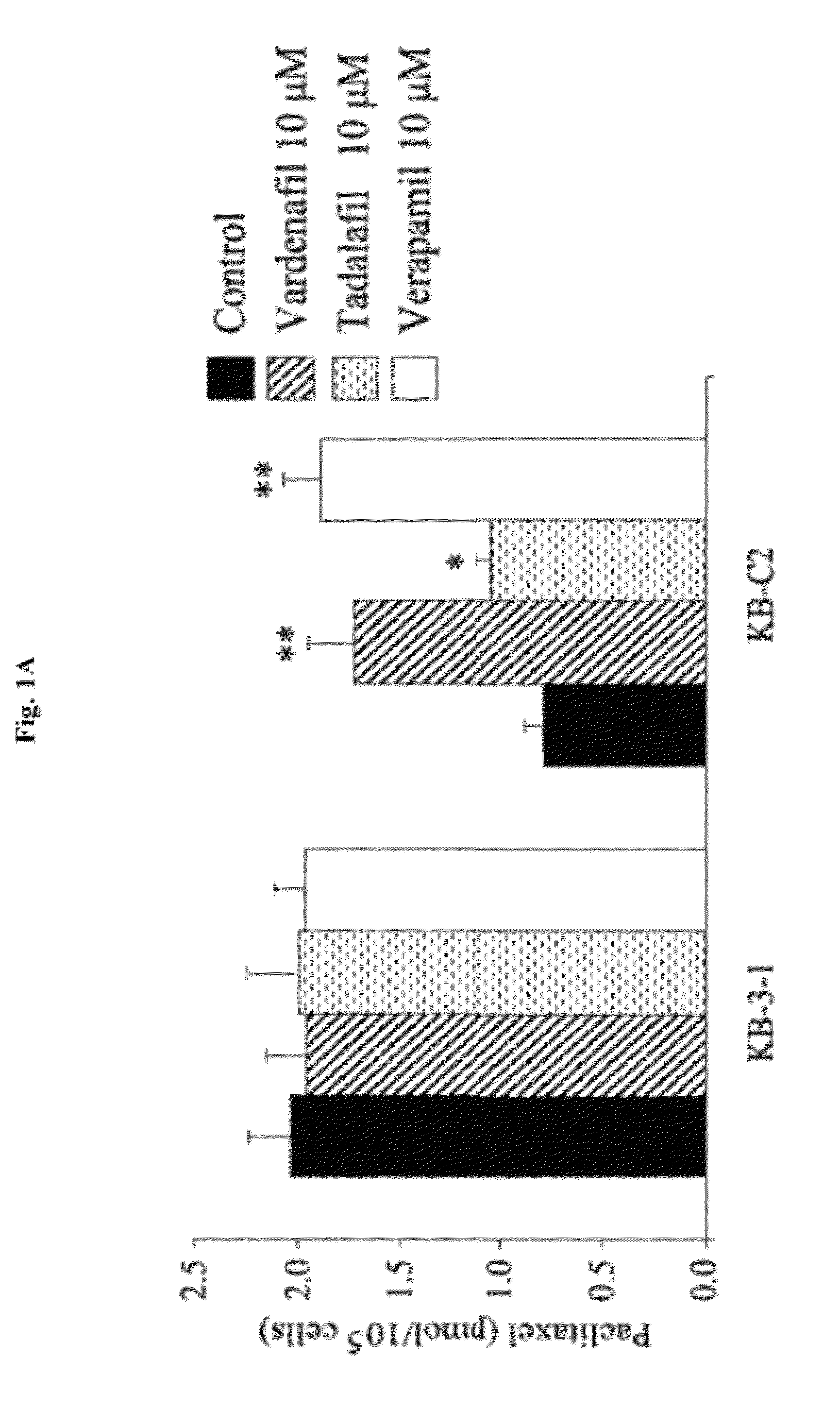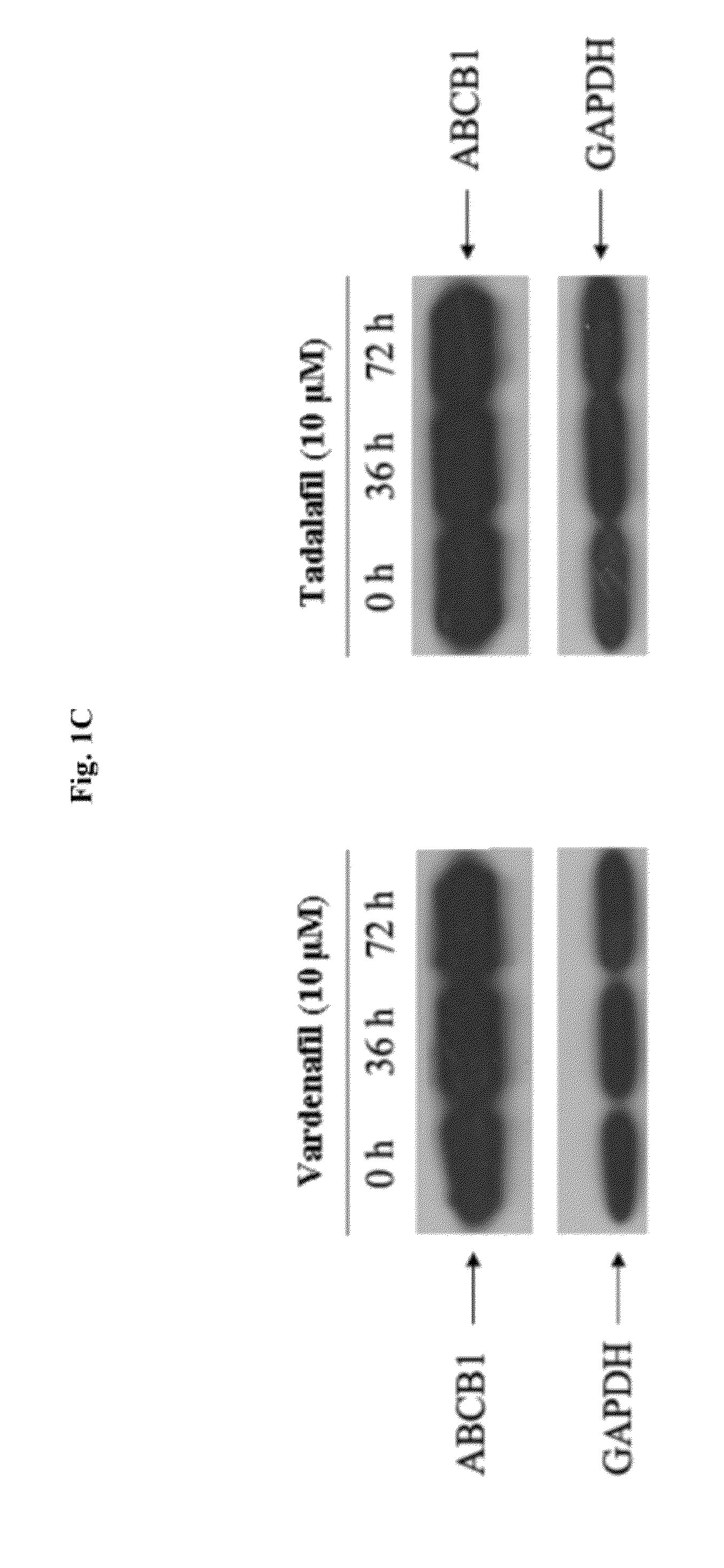Use of phosphodiesterase inhibitors for treating multidrug resistance
a technology of phosphodiesterase inhibitors and multidrug resistance, which is applied in the direction of drug compositions, biocide, heterocyclic compound active ingredients, etc., can solve the problems of decreased clearance, undesirable adverse effects, and decreased treatment success rate, and achieve the inhibition of abcg2 transporter activity, abcc10 transporter activity, and abcb1 transporter activity.
- Summary
- Abstract
- Description
- Claims
- Application Information
AI Technical Summary
Benefits of technology
Problems solved by technology
Method used
Image
Examples
example 1
Effects of Vardenafil and Tadalafil on ABCB1 / P-Glycoprotein-Mediated Multidrug Resistance
Example 1.1
Materials and Methods
Example 1.1.a
Reagents
[0094]Vardenafil and tadalafil were purchased from Toronto Research Chemicals Inc. (Ontario, Canada). [3H]-paclitaxel (37.9 Ci / mmol) was purchased from Moravek Biochemicals Inc (Brea, Calif.). [125I]-Iodoarylazidoprazosin (IAAP) (2,200 Ci / mmol) was obtained from Perkin Elmer Life Sciences (Boston, Mass.). Monoclonal antibody C-219 (against ABCB1) was acquired from Signet Laboratories Inc. (Dedham, Mass.). Anti-glyceraldehyde-3-phosphate dehydrogenase (GAPDH) monoclonal antibody (14C10) was obtained from Cell Signaling Technology, Inc. (Danvers, Mass.). Fumitremorgin C (FTC) was synthesized by Thomas McCloud Developmental Therapeutics Program, Natural Products Extraction Laboratory, NCI, NIH (Bethesda, Md.). ONO1078 was a gift from Dr. Akiyama (Kagoshima University, Japan). Paclitaxel, vincristine (VCR), colchicine, 7-ethyl-10-hydroxy-20(S)-cam...
example 1.1
[0104]All experiments were repeated at least three times and the differences were determined by using the Student's t-test. The statistical significance was determined at p<0.05.
example 1.2
Vardenafil Enhances Drug Sensitivity of ABCB1- but not ABCC1- or ABCG2-Overexpressing Cancer Cells
[0105]Cytotoxic effects of vardenafil and tadalafil on different cell lines using the MTT assay were tested, and neither vardenafil nor tadalafil inhibited the growth of any cell lines tested at concentrations of up to 20 μM.
[0106]Subsequently, the effect of vardenafil or tadalafil on the sensitivity of anticancer drugs in ABCB1-, ABCC1-, and ABCG2-overexpressing MDR cells was tested. At 5 and 10 μM, vardenafil produced a concentration-dependent increase in cytotoxicity of colchicine and paclitaxel in ABCB1-overexpressing drug-selected cell line KB-C2, but not parental sensitive KB-C2 cells (Table 4). In order to eliminate the possibility of multiple factors playing a role in drug-selected cell lines, the effect of vincristine and paclitaxel cytotoxicity on ABCB1-transfected HEK293 / ABCB1 cells was also measured. Vardenafil increased the sensitivity of ABCB1-transfected HEK / ABCB1 cells t...
PUM
| Property | Measurement | Unit |
|---|---|---|
| concentrations | aaaaa | aaaaa |
| pH | aaaaa | aaaaa |
| temperature | aaaaa | aaaaa |
Abstract
Description
Claims
Application Information
 Login to View More
Login to View More - R&D
- Intellectual Property
- Life Sciences
- Materials
- Tech Scout
- Unparalleled Data Quality
- Higher Quality Content
- 60% Fewer Hallucinations
Browse by: Latest US Patents, China's latest patents, Technical Efficacy Thesaurus, Application Domain, Technology Topic, Popular Technical Reports.
© 2025 PatSnap. All rights reserved.Legal|Privacy policy|Modern Slavery Act Transparency Statement|Sitemap|About US| Contact US: help@patsnap.com



